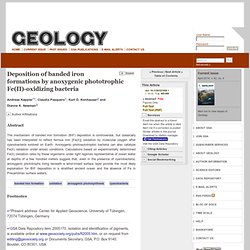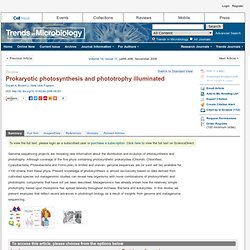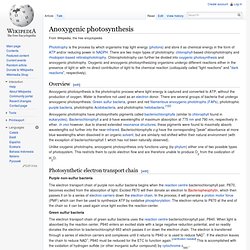Zoom
Trash

Light utilization efficiency in photosynthetic microbial mats - Al-Najjar - 2011 - Environmental Microbiology - Wiley Online Library. Bacterial anoxygenic photosynthesis on plant leaf surfaces - Atamna-Ismaeel - 2012 - Environmental Microbiology Reports. Deposition of banded iron formations by anoxygenic phototrophic Fe(II)-oxidizing bacteria. + Author Affiliations Abstract The mechanism of banded iron formation (BIF) deposition is controversial, but classically has been interpreted to reflect ferrous iron [Fe(II)] oxidation by molecular oxygen after cyanobacteria evolved on Earth.

Anoxygenic photoautotrophic bacteria can also catalyze Fe(II) oxidation under anoxic conditions. Trends in Microbiology - Prokaryotic photosynthesis and phototrophy illuminated. To view the full text, please login as a subscribed user or purchase a subscription.

Click here to view the full text on ScienceDirect. Genome sequencing projects are revealing new information about the distribution and evolution of photosynthesis and phototrophy. The Ability to Convert Light Into Chemical Energy Is Ancient - Biochemistry - NCBI Bookshelf. Anoxygenic photosynthesis. Phototrophy is the process by which organisms trap light energy (photons) and store it as chemical energy in the form of ATP and/or reducing power in NADPH.

There are two major types of phototrophy: chlorophyll-based chlorophototrophy and rhodopsin-based retinalophototrophy. Chlorophototrophy can further be divided into oxygenic photosynthesis and anoxygenic phototrophy. Oxygenic and anoxygenic photosynthesizing organisms undergo different reactions either in the presence of light or with no direct contribution of light to the chemical reaction (colloquially called "light reactions" and "dark reactions", respectively). Plants - ARKive species search results. Occurrence of facultative anoxygenic photosynthesis among filamentous and unicellular cyanobacteria.